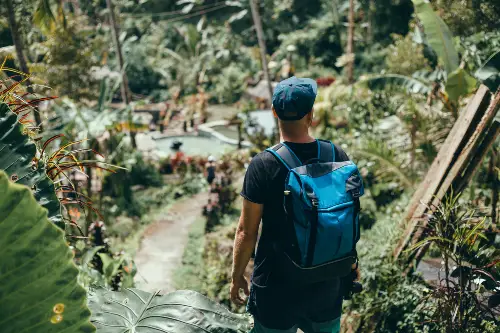The Dominican Republic may be famous for its sun-drenched beaches and luxury resorts, but beyond the all-inclusive borders lies a wilder, greener world. Mountain rivers, tropical forests, and protected parks stretch across the country, offering travelers a chance to experience nature up close—while supporting local communities and conservation efforts.
If you’re ready to explore the island’s eco side, here are the Dominican Republic’s most inspiring sustainable adventures.
1. Jarabacoa – The Mountain Escape
Nestled in the Central Mountains, Jarabacoa—often called the “city of eternal spring”—is the heart of eco-tourism in the DR. Its cool climate and pine-covered hills are perfect for outdoor adventures.
Why go: Rafting, canyoning, and hiking to waterfalls in postcard-perfect landscapes.
Top experiences:
- White-water rafting on the Yaque del Norte River
- Hike to Salto de Jimenoa and Salto Baiguate waterfalls
- Horseback rides through lush mountain trails
Stay: Choose from eco-lodges and boutique retreats powered by renewable energy and serving locally sourced cuisine.
2. Constanza – Cool Air and Cloud Forests
Just an hour from Jarabacoa, Constanza is a highland haven of fresh air, fertile valleys, and misty trails.
Why go: A peaceful escape surrounded by farms, strawberry fields, and the enchanting Ebano Verde Scientific Reserve.
Top experiences:
- Hike to Aguas Blancas, the Caribbean’s highest waterfall
- Visit local farms and sample fresh produce
- Wander through trails dotted with orchids and native birds
3. Los Haitises National Park – Mangroves and Ancient Caves
A crown jewel of Dominican conservation, Los Haitises is a wonderland of limestone cliffs, mangrove forests, and hidden caves once used by the Taíno people.
Why go: Ideal for birdwatchers, kayakers, and nature photographers seeking untouched beauty.
Top experiences:
- Kayak through mangrove tunnels
- Visit caves adorned with ancient petroglyphs
- Spot pelicans, frigatebirds, and manatees
Access: Reachable by boat from Samaná or Sabana de la Mar.
4. Samaná Peninsula – Whales and Waterfalls
Samaná combines postcard beaches with rich marine life and small-town charm.
Why go: Between January and March, humpback whales migrate to Samaná Bay—one of the world’s best whale-watching spots.
Top experiences:
- Watch humpback whales breach in the bay
- Trek or ride horseback to El Limón Waterfall
- Relax on unspoiled beaches like Los Cacaos or Rincón
Tip: Choose eco-certified whale-watching operators who follow strict conservation practices.
5. Lake Enriquillo – Flamingos and Salt Flats
Located below sea level in the arid southwest, Lake Enriquillo feels like another planet—its turquoise waters contrasting with desert terrain.
Why go: It’s a haven for pink flamingos, crocodiles, and rare iguanas.
Top experiences:
- Boat to Isla Cabritos, home to endemic wildlife
- Visit nearby Lago Rincón for birdwatching
- Marvel at the surreal desert-meets-lake scenery
Tip: Don’t forget your binoculars—this is birder paradise.
6. Bahoruco National Park – Hiking and Biodiversity
Part of the UNESCO-designated Jaragua-Bahoruco-Enriquillo Biosphere Reserve, this park is a biodiversity hotspot ranging from dry forest to highland pine woods.
Why go: For rare orchids, endemic birds, and some of the DR’s best hiking trails.
Top experiences:
- Trek through the Sierra de Bahoruco mountains
- Visit coffee-farming communities and meet local growers
- Stay in community-run eco-lodges that support conservation efforts
7. Jaragua National Park – Wild Beaches and Lagoons
The largest protected area in the Caribbean, Jaragua is a world of contrasts—arid plains, lagoons, and remote, untouched beaches.
Why go: To witness sea turtle nesting sites and one of the most pristine coastlines on Earth.
Top experiences:
- Birdwatching at Laguna de Oviedo
- Visit Bahía de las Águilas, often called the most beautiful beach in the Caribbean
Tip: Bring a 4×4—the journey is rugged, but the isolation is part of its magic.
Tips for Responsible Eco-Travel in the DR
- Stay green: Choose certified eco-lodges that employ locals and use renewable energy.
- Respect wildlife: Keep your distance and never feed animals.
- Hire local guides: They know the land best and help sustain their communities.
- Leave no trace: Carry out all trash, use reef-safe sunscreen, and minimize plastic.
Final Thoughts
The Dominican Republic’s wild side is its best-kept secret. From rafting in Jarabacoa to kayaking in Los Haitises or whale-watching in Samaná, every eco-adventure here connects you to nature—and to the people who protect it. Traveling sustainably doesn’t mean giving up comfort—it means gaining a deeper appreciation for the island’s true beauty.




Comments are closed